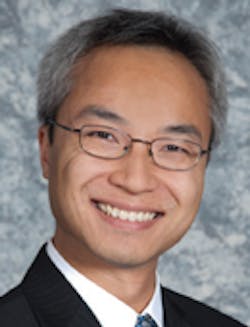Focus on oral cancer
by David Gane, DDS
Oral cancer is a focus for dentists as public awareness of head-and-neck cancers increases. Recently Dr. David Gane, CEO of LED Medical Diagnostics Inc., sat down with Dr. Samson Ng, a board-certified specialist in oral medicine and Oral & Maxillofacial pathology. Dr. Gane wants to share Dr. Ng's insights to general dentists on oral cancer screening and diagnosis.
Dr. David Gane:When it comes to oral mucosal abnormalities, what should general dentists be looking for?
Dr. Samson Ng: Normal oral mucosa is expected to be pinky red with a shiny surface, and should be adequately wetted from saliva. Any tissue beyond this description might reflect a problem. Dentists should rely on their knowledge and experience when it comes to the diagnosis of diseases of the oral cavity. In reality, oral mucosal disease commonly occurs because of infection or trauma, which can be managed by removing the etiology or with antimicrobial agents. Common conditions should be resolved in a week or two after initial management. However, there are oral conditions that are inflammatory, precancerous, or cancerous in nature that would be refractory to standard management. A further diagnostic workup with possible referral care is recommended.
Gane:What patient populations are at risk for developing oral cancer? Who should be screened, and how often?
Ng: Oral cancer is generally referred to as oral squamous cell carcinoma (SSC), which arises from the pinky mucosal surface cells known as epithelium. Typically, patients with excessive alcohol consumption or chronic smoking are affected. A family history of head-and-neck cancer is also a risk factor. Recently, there's been discussion of human papillomavirus infection (HPV) being related to oral SCC, similar to the relationship of cervical cancer and HPV infection. Based on the emerging data, all adults should have an oral health screening at least once a year as part of a typical oral examination.
Gane: What are some best practices for general dentists to adopt in communicating suspicious findings to referral partners?
Ng: Education is the best way to bring the dental industry to the current field of knowledge. Through learning, there are opportunities to build professional relationships with referral partners that are focused on patient care and teamwork.
When a general dentist encounters unresolved oral conditions, I may receive a phone call or intraoral imaging (photo, fluorescent imaging, X-ray, or Cone Beam CT) files. I screen the information and triage the patient care accordingly. New technologies are making this process so much easier, and are opening the door for efficient communication and information sharing.
Gane:Similarly, what are some best practices for talking to patients about oral cancer exams, fees, and suspicious findings?
Ng: Cancer can be a disturbing word for most people, so a nonthreatening approach is key. Waiting-room information such as posters and brochures helps to start the conversation before the patient arrives chairside. Telling your patient, "I am going to find out if you have cancer or not" is not a great approach. However, saying, "I am going to look at the oral tissue to make sure it is healthy" is a more positive approach and opens the door to discuss the procedure fee.
If a suspicious lesion is present, I would say, "There are areas that look beyond what I typically expect from screening, and I would like to refer you to make sure we are not missing something."
Gane:How would you best characterize the role of fluorescence imaging in the screening and early detection of mucosal disease, including oral cancer?
Ng: Fluorescence imaging should be used as an adjunct tool to conventional oral examination. It helps clinicians detect location and size of potential oral mucosal abnormalities, including oral SCC. Of course, this imaging is not able to make a diagnosis, nor is it intended to replace the diagnostic skill set of clinicians, but it definitely enhances the visual acuity of the clinician's eye. I use it for almost all patients.
Gane:How can the comprehensive oral exam add to the bottom line for a practice?
Ng: Dentistry is no longer drill, fill, and bill. We are clinicians with expertise in diagnosis and management of oral mucosal disease. Our patients depend on us to look after their overall oral health. Comprehensive screening is about developing and earning your patients' trust and ongoing patronage.
Samson Ng, BSc (Pharm), DMD, MSc, FRCD(C), FDSRCSEd, Dip. ABOM, Dip. ABOMP, Certified Specialist in Oral Medicine and Oral Pathology, is currently appointed as clinical assistant professor at the University of British Columbia, Director of the Oral Care Program for Medically Complex Patients (OCPMCP) at the Dept. of Dentistry of the Vancouver General Hospital, and Oral Oncology Staff at the BC Cancer Agency. Dr. Ng's clinical research focuses on early detection of oral precancer lesions and photodynamic therapy for oral pathogens. Currently, he is working on research to expand the application of direct fluorescence visualization in the oral cavity.
Past DE Issues

